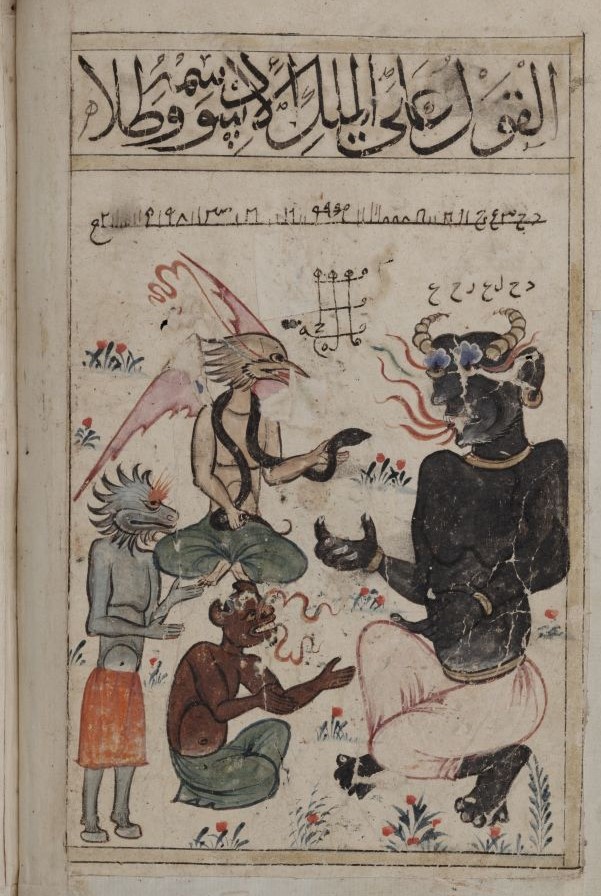
Medieval Muslims wrote extensively about plagues. Theories ranged from the natural, to the will of the divine. But some spoke of the hidden influences of jinn and stars.
A thread on the astrology and jinn of plagues in the medieval Islamic world
A thread on the astrology and jinn of plagues in the medieval Islamic world
Jinn were invisible beings, often associated with the dangers of the desert. They could cause mischief for travelers but also frequented cities.
One way they caused mayhem was through sickness and plague.
One way they caused mayhem was through sickness and plague.
The jinn were said to possess poison arrows or spears called “ta’n” which they used to afflict people. Individually, they could strike a human with illness and fever, but should plague overtake a city then it was described as a battalion of jinn descending with their ta’n.
There were certain times where the arrows of the jinn were considered especially dangerous—high noon, twilight, and midnight.
One of the oldest jinn associated with plagues is Muharriq. Likely originally a pre-Islamic deity, he develops a reputation as fiery wind of disease.
Plague as a hot, corrupting wind was a common theme in the literature. This type of scorching wind was called “samum” which was believed to be so pure a heat it had no true source.
The description reflects a clear desert culture.
The description reflects a clear desert culture.
Samum becomes both a jinn, a being of immense power, but also the elemental source of all jinn as mentioned in Qur’an 15:27.
His heat penetrates the skin causing plague and fevers.
His heat penetrates the skin causing plague and fevers.
Samum, Muharriq, and Al Ahmar all reflect an understanding of plague as associated with heat and winds.
But the cold could also cause plagues of a different kind.
The bitterly cold jinn king, Maymun also cause plagues, those which came with uncontrollable shivers and coughs.
The bitterly cold jinn king, Maymun also cause plagues, those which came with uncontrollable shivers and coughs.
In fact it is said when the jinn kings Maymun and Ahmar meet, their mere presence causes plagues.
This likely refers to an astrological understanding of plague. Maymun is associated with Saturn and Ahmar with Mars. There are several astrological warnings about conjunction of these two maleifcs.
Abu Ma’shar and Usaybi’a both warn of Mars and Saturn conjunctions in Cancer and Aquarius which portend bloodshed and plague.
Conjunctions in Cancer were especially dire as Cancer came to be associated with Muslim lands.
Conjunctions in Cancer were especially dire as Cancer came to be associated with Muslim lands.
Astrologers would pay particular attention to the Lord of the Year, which if coincided with Mars during a conjunction of Mars and Saturn in Cancer or Aquarius then plague was imminent.
So too did Jupiter and Saturn conjunctions in Aquarius herald pestilent winds, corruption of the air, and plagues of breath
Various lunar mansions also warned of plagues.
The lunar mansions were 28 stations the moon traveled through with their own associations used in astrology and magic.
Abu Ma’shar’s apprentice warns if Saturn resides in the 9th mansion, Al Tarf then plague was likely.
The lunar mansions were 28 stations the moon traveled through with their own associations used in astrology and magic.
Abu Ma’shar’s apprentice warns if Saturn resides in the 9th mansion, Al Tarf then plague was likely.
Al Tarf is located in Cancer, so we again see the association of fire and water; Cancer is a cold and wet sign in the hot and dry season of summer.
Astrologers debated whether plagues were caused by the influence of stars, or if they merely reflected seasonal, cyclical events; like a farmer with harvest season.
Others argued stars didn’t cause plague, for only God could cause anything, rather they reflected God’s plan.
Others argued stars didn’t cause plague, for only God could cause anything, rather they reflected God’s plan.
Yet despite elements of determinism, both astrological and jinn plagues were treated with remedies, natural and magical.
A talisman made when the moon was in the 18th mansion, Al Qalb with the image of a serpent could repel plagues if worn on the body
Supplications and invocations of the Names of God were also common.
Al Baqi, The Everlasting, was recited 136 times and dissolved in water as protection against plague.
Al Baqi, The Everlasting, was recited 136 times and dissolved in water as protection against plague.
If you’re interested in more talismans take a look at my patreon where I’ve uploaded several examples of talismans and posted an introductory podcast on them.
patreon.com/headonhistory
patreon.com/headonhistory
Many of these theories about plagues often overlapped with medicinal explanations and religious explanation, indicating variations in thought and the complex nuances of premodern intellectual traditions.
I’ll cover more jinn, magic, and astrology in future threads.
• • •
Missing some Tweet in this thread? You can try to
force a refresh




